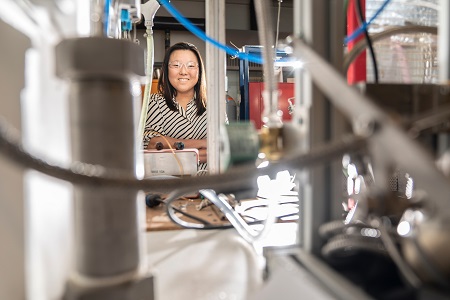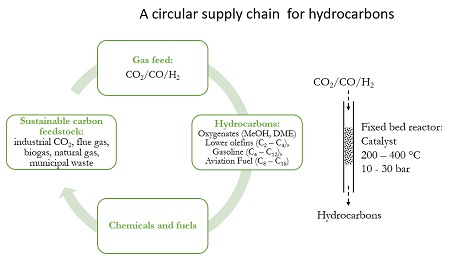Vliegen op kooldioxide
Gedragsverandering is belangrijk om het broeikaseffect op onze planeet te beperken. Maar sommige gewoonten, zoals vliegen, kunnen we maar moeilijk aanpassen. In zo’n geval kan een technische oplossing een belangrijke rol spelen. Er zijn bijvoorbeeld al verschillende manieren bekend om synthetische kerosine te maken. Aan de RUG combineert Jingxiu Xie haar kennis van katalyse en chemische technologie gecombineerd om kerosine te maken uit kooldioxide.
Het is niet echt lastig voor een chemicus om van kooldioxide (CO2) kerosine te maken. Deze vliegtuigbrandstof bestaat uit koolwaterstoffen van acht tot zestien koolstofatomen. ‘De eerste stap is om kooldioxide om te zetten in het veel reactievere koolmonoxide’, zegt Jingxiu Xie, assistent hoogleraar Katalytische Processen voor Gasconversies. ‘We weten hoe dit kan, maar het kost wel veel energie.’ Door vervolgens koolmonoxide te combineren met waterstof (H2) zjin koolwaterstoffen te vormen. ‘Koolmonoxide, waterstof en zuurstof is het klassieke syngas, dat je in vloeibare brandstof kunt omzetten via de klassieke Fischer-Tropsch synthesereactie.’ Oliebedrijf Shell heeft deze methode onlangs gebruikt om de mogelijkheden van synthetische kerosine te demonstreren.

Afvalgassen
Maar Xie wil niet beginnen met een schone bron van koolmonoxide (CO). In plaats daarvan wil ze afvalgassen gebruiken van grote uitstoters van broeikasgassen, zoals Tata Steel of de RWE energiecentrale in Eemshaven. Dit afvalgas bevat allerlei andere moleculen naast koolmonoxide en waterstof. ‘En de commerciële katalysatoren die in de Fischer-Tropsch reactie worden gebruikt werken niet goed in zo’n gasmengsel’, zegt Xie. ‘We weten dat het mogelijk is om in het laboratroium met een kobalt-katalysator vliegtuigbrandstof te maken uit koolmonoxide en waterstof. Maar vervuilende stoffen in het afvalgas kunnen kortere koolwaterstoffen opleveren. We moeten dus kennis uit de katalyse combineren met kennis over chemische productietechnologie om een proces aan te ontwikkelen dat doet wat wij willen: een volledige groene productie van kerosine.’
Bovendien is de hoeveelheid energie die nodig is om koolmonoxide te maken van kooldioxide en om groene waterstof te produceren een probleem als je echt groene kerosine wilt maken. De meeste waterstof die nu beschikbaar is, is gemaakt van aardgas (methaan) – geen groene bron dus. Xie: ‘En er is niet genoeg duurzame energie om ongelimiteerd groene waterstof te kunnen maken door elektrolyse van water. Daarom wil ze het hele proces zo energie-efficiënt mogelijk maken. Dat kan bijvoorbeeld door het aantal zuiveringsstappen zo klein mogelijk te maken. ‘Ik heb twee jaar in de industrie gewerkt, dus ik weet hoe ik zoiets aan moet pakken.’

Kleine fabrieken
Haar ideeën om koolwaterstoffen te maken uit afvalgas kan de hele chemische industrie veranderen. ‘Chemische fabrieken zijn nu vooral erg groot, zodat ze zo goedkoop mogelijk kunnen produceren. Maar als we verschillende soorten koolstof als grondstof gaan gebruiken in onze processen is het beter kleine fabrieken bouwen dichtbij de bron van die grondstof. Dat is wel weer duurder dan de huidige grote fabrieken, nog een reden om het productieproces zo eenvoudig en dus goedkoop mogelijk te maken.’ De chemische industrie gebruikt vooral onverzadigde koolwaterstoffen, zogeheten olefines, die om een andere synthetische route vragen dan kerosine.
Xie denkt dat haar aanpak binnen niet al te lange tijd succes zal hebben. Er komt ook steeds meer geld beschikbaar voor haar type onderzoek. Dat onderzoek is een typisch voorbeeld van werk dat zal profiteren van FutureCarbonNL, een samenwerking van Nederlandse universiteiten, kennisinstellingen, chemische en andere industrieën, het MKB en groene startups. FutureCarbonNL dient binnenkort een voorstel in ter waarde van zo’n zeshonderd miljoen euro bij het Nederlandse Groeifonds. Een deel van dat geld zal zeker gaan naar onderzoek van het afvangen en nuttig gebruiken van koolstof. Xie: Als FutureCarbonNL succesvol is zal onze groep zeker meedingen naar onderzoeksubsidies.’ Dat zal haar en haar team helpen om processen te ontwikkelen voor de productie van groene kerosine voor de luchtvaart en voor olefines, waarmee ze tegelijkertijd een hele nieuwe opzet van de chemische industrie mogelijk maakt.
Zie ook:
Bodembacterie maakt eiwitten en geneesmiddelen van kooldioxide
Website FutureCarbonNL
Meer nieuws
-
11 december 2025
Stormachtige planeten en een onverwachtse atmosfeer
-
09 december 2025
RUG-hoogleraar bij COP30: ‘Het is altijd drama’

